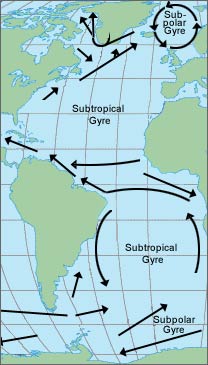Hydrosphere Contents
4. Oceans
Circular ocean currents are called gyres
The current which flows across the North Atlantic is called the Gulf Stream. When it reaches Europe part of the Gulf Stream flows north into the Norwegian and Greenland seas and the other part flows south past Spain and Portugal and then returns to the Americas as the easterly flowing N. Equatorial current. There is a corresponding circulation gyre in the S. Atlantic except that it flows anti-clockwise with the westerly current flowing from Argentina to Southern Africa.

Similar gyres are found in each of the major oceans of the world. Typically these surface currents only control the water flow down to a depth of 200-300 metres. Beneath that the three dimensional pattern of currents is controlled not by wind but by the density of seawater, according to its temperature and its salinity. Cold saline water is heavier than warm fresh water. Considering the Atlantic as an example, surface water flows into the Greenland sea via the Gulf Stream. The further north the water goes, the colder it becomes until eventually it is so cold (1-2°C) that it becomes heavier than the water layers below the surface and it sinks down to the bottom of the ocean.
How is the three-dimensional pattern of ocean currents controlled below 200-300 metres?